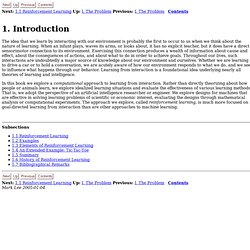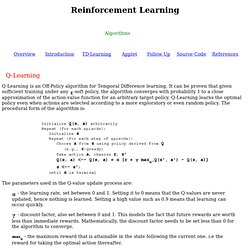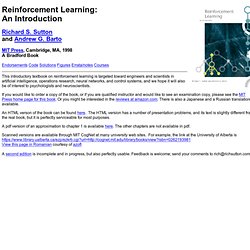

1. Introduction. Next: 1.1 Reinforcement Learning Up: I.

The Problem Previous: I. The Problem Contents The idea that we learn by interacting with our environment is probably the first to occur to us when we think about the nature of learning. When an infant plays, waves its arms, or looks about, it has no explicit teacher, but it does have a direct sensorimotor connection to its environment. Exercising this connection produces a wealth of information about cause and effect, about the consequences of actions, and about what to do in order to achieve goals. Reinforcement learning. Reinforcement learning (RL) is learning by interacting with an environment.

An RL agent learns from the consequences of its actions, rather than from being explicitly taught and it selects its actions on basis of its past experiences (exploitation) and also by new choices (exploration), which is essentially trial and error learning. The reinforcement signal that the RL-agent receives is a numerical reward, which encodes the success of an action's outcome, and the agent seeks to learn to select actions that maximize the accumulated reward over time. (The use of the term reward is used here in a neutral fashion and does not imply any pleasure, hedonic impact or other psychological interpretations.) Overview In general we are following Marr's approach (Marr et al 1982, later re-introduced by Gurney et al 2004) by introducing different levels: the algorithmic, the mechanistic and the implementation level. The Algorithmic level (Machine-Learning perspective) In general. (Crites and Barto 1996); Algorithms and Representations for Reinforcement Learning.
2011_1427.pdf (application/pdf Object) Shimon Whiteson: Adaptive Representations for Reinforcement Learning. • Sorted by Date • Classified by Publication Type • Shimon Whiteson.

Adaptive Representations for Reinforcement Learning, Studies in Computational Intelligence, Springer, Berlin, Germany, 2010. Download Abstract This book presents new algorithms for reinforcement learning, a form of machine learning in which an autonomous agent seeks a control policy for a sequential decision task. BibTeX Entry. Reinforcement Learning - Algorithms. The parameters used in the Q-value update process are: - the learning rate, set between 0 and 1.

Setting it to 0 means that the Q-values are never updated, hence nothing is learned. Setting a high value such as 0.9 means that learning can occur quickly. - discount factor, also set between 0 and 1. This models the fact that future rewards are worth less than immediate rewards. . - the maximum reward that is attainable in the state following the current one. i.e the reward for taking the optimal action thereafter. This procedural approach can be translated into plain english steps as follows: Initialize the Q-values table, Q(s, a). Sarsa The Sarsa algorithm is an On-Policy algorithm for TD-Learning.
As you can see, there are two action selection steps needed, for determining the next state-action pair along with the first. And have the same meaning as they do in Q-Learning. Example To highlight the difference between Q-Learning and Sarsa, an example from [1] will be used. Next... Reinforcement Learning Introduction. Reinforcement Learning / Algorithms of Reinforcement Learning. Sutton & Barto Book: Reinforcement Learning: An Introduction. MIT Press, Cambridge, MA, 1998 A Bradford Book Endorsements CodeSolutions FiguresErrata/notes Courses This introductory textbook on reinforcement learning is targeted toward engineers and scientists in artificial intelligence, operations research, neural networks, and control systems, and we hope it will also be of interest to psychologists and neuroscientists.

If you would like to order a copy of the book, or if you are qualified instructor and would like to see an examination copy, please see the MIT Press home page for this book. Or you might be interested in the reviews at amazon.com. There is also a Japanese and a Russian translation available. An HTML verson of the book can be found here. A pdf version of an approximation to chapter 1 is available here. Scanned versions are available through MIT CogNet at many university web sites. A second edition is incomplete and in progress, but also perfectly usable. Reinforcement Learning Warehouse.